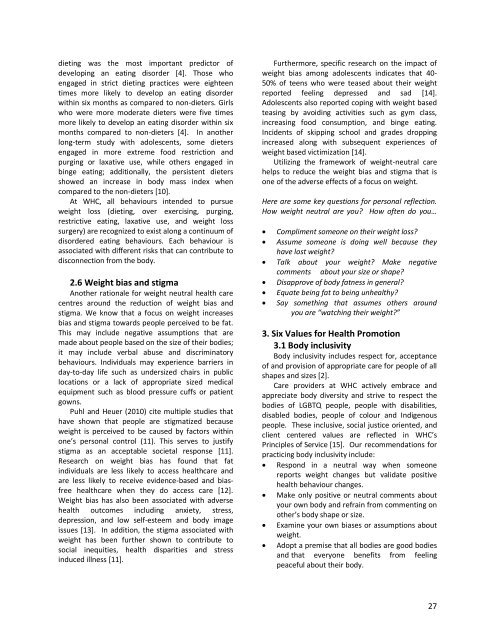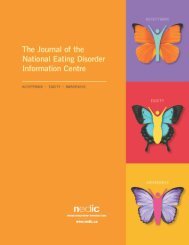NEDIC Conference Journal 2018
You also want an ePaper? Increase the reach of your titles
YUMPU automatically turns print PDFs into web optimized ePapers that Google loves.
dieting was the most important predictor of<br />
developing an eating disorder [4]. Those who<br />
engaged in strict dieting practices were eighteen<br />
times more likely to develop an eating disorder<br />
within six months as compared to non-dieters. Girls<br />
who were more moderate dieters were five times<br />
more likely to develop an eating disorder within six<br />
months compared to non-dieters [4]. In another<br />
long-term study with adolescents, some dieters<br />
engaged in more extreme food restriction and<br />
purging or laxative use, while others engaged in<br />
binge eating; additionally, the persistent dieters<br />
showed an increase in body mass index when<br />
compared to the non-dieters [10].<br />
At WHC, all behaviours intended to pursue<br />
weight loss (dieting, over exercising, purging,<br />
restrictive eating, laxative use, and weight loss<br />
surgery) are recognized to exist along a continuum of<br />
disordered eating behaviours. Each behaviour is<br />
associated with different risks that can contribute to<br />
disconnection from the body.<br />
2.6 Weight bias and stigma<br />
Another rationale for weight neutral health care<br />
centres around the reduction of weight bias and<br />
stigma. We know that a focus on weight increases<br />
bias and stigma towards people perceived to be fat.<br />
This may include negative assumptions that are<br />
made about people based on the size of their bodies;<br />
it may include verbal abuse and discriminatory<br />
behaviours. Individuals may experience barriers in<br />
day-to-day life such as undersized chairs in public<br />
locations or a lack of appropriate sized medical<br />
equipment such as blood pressure cuffs or patient<br />
gowns.<br />
Puhl and Heuer (2010) cite multiple studies that<br />
have shown that people are stigmatized because<br />
weight is perceived to be caused by factors within<br />
one’s personal control (11). This serves to justify<br />
stigma as an acceptable societal response [11].<br />
Research on weight bias has found that fat<br />
individuals are less likely to access healthcare and<br />
are less likely to receive evidence-based and biasfree<br />
healthcare when they do access care [12].<br />
Weight bias has also been associated with adverse<br />
health outcomes including anxiety, stress,<br />
depression, and low self-esteem and body image<br />
issues [13]. In addition, the stigma associated with<br />
weight has been further shown to contribute to<br />
social inequities, health disparities and stress<br />
induced illness [11].<br />
Furthermore, specific research on the impact of<br />
weight bias among adolescents indicates that 40-<br />
50% of teens who were teased about their weight<br />
reported feeling depressed and sad [14].<br />
Adolescents also reported coping with weight based<br />
teasing by avoiding activities such as gym class,<br />
increasing food consumption, and binge eating.<br />
Incidents of skipping school and grades dropping<br />
increased along with subsequent experiences of<br />
weight based victimization [14].<br />
Utilizing the framework of weight-neutral care<br />
helps to reduce the weight bias and stigma that is<br />
one of the adverse effects of a focus on weight.<br />
Here are some key questions for personal reflection.<br />
How weight neutral are you? How often do you…<br />
Compliment someone on their weight loss?<br />
Assume someone is doing well because they<br />
have lost weight?<br />
Talk about your weight? Make negative<br />
comments about your size or shape?<br />
Disapprove of body fatness in general?<br />
Equate being fat to being unhealthy?<br />
Say something that assumes others around<br />
you are “watching their weight?”<br />
3. Six Values for Health Promotion<br />
3.1 Body inclusivity<br />
Body inclusivity includes respect for, acceptance<br />
of and provision of appropriate care for people of all<br />
shapes and sizes [2].<br />
Care providers at WHC actively embrace and<br />
appreciate body diversity and strive to respect the<br />
bodies of LGBTQ people, people with disabilities,<br />
disabled bodies, people of colour and Indigenous<br />
people. These inclusive, social justice oriented, and<br />
client centered values are reflected in WHC’s<br />
Principles of Service [15]. Our recommendations for<br />
practicing body inclusivity include:<br />
Respond in a neutral way when someone<br />
reports weight changes but validate positive<br />
health behaviour changes.<br />
Make only positive or neutral comments about<br />
your own body and refrain from commenting on<br />
other’s body shape or size.<br />
Examine your own biases or assumptions about<br />
weight.<br />
Adopt a premise that all bodies are good bodies<br />
and that everyone benefits from feeling<br />
peaceful about their body.<br />
27




